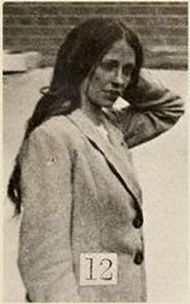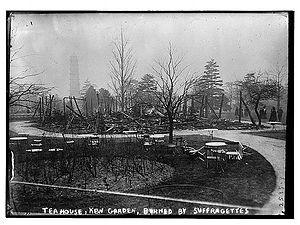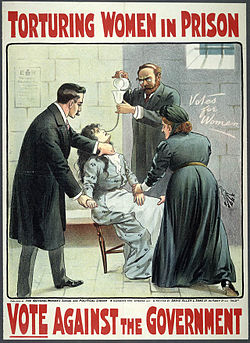- Lilian Lenton
-


Lenton in a Home Office surveillance photograph of c.1912 Lilian Ida Lenton (January 1891 – October 28, 1972) was an English dancer, suffragist, arsonist, and winner of a French Red Cross medal for her service as an Orderly in World War I.[1]
Contents
Early years
'Lillie' Lenton was born in Leicester in 1891, the eldest daughter of a carpenter-joiner. On leaving school she trained to be a dancer, but, after hearing Emmeline Pankhurst speak, she " ... made up my mind that night that as soon as I was twenty-one and my own boss ... I would volunteer".[2] On attaining that age, she joined the Women's Social and Political Union, and with fellow members took part in a window-smashing campaign in March 1912. She was jailed for two months under the alias 'Ida Inkley'.[3] s.b
Notoriety
In early 1913, with Olive Wharry, she began a series of arson attacks in London, and was arrested in February 1913 on suspicion of having set on fire the Tea House at Kew Gardens.[4][5] In Holloway Prison she held a hunger strike for two days before being forcibly fed, which caused her to become seriously ill with pleurisy caused by food entering her lungs.[6] It took two doctors and seven wardens to restrain her. She was quickly and quietly released. Her case created an outrage among the public, made worse by the fact that the Home Secretary, Reginald McKenna, denied that she had been force fed and that her illness was actually caused by her hunger strike.[3] However, Home Office papers show that she was force fed on February 23, 1913.[7] A letter to The Times in 1913, from Victor Horsley, a leading surgeon, claimed “...the Home Secretary’s attempted denial that Miss Lenton was nearly killed by the forcible feeding is worthless...she was tied into a chair and her head dragged backward across the back of the chair by her hair. The tube was forced through the nose twice . . . after the second introduction when the food was poured in, it caused violent choking.”[8] To avoid more such political embarrassment,[6] the Government rushed through its 'Cat and Mouse Act' in April 1913, which stated that hunger-striking suffragette 'mice' could be released on temporary licence to recover their health, when the security forces could re-arrest them.
In June 1913 Lenton was arrested in Doncaster and charged as 'May Dennis' with being on the premises of an unoccupied house which had been set on fire. She was released from Armley Prison in Leeds after several days; on this occasion there had been no attempt to force feed her. Her accomplice in the arson attack was a local journalist called Harry Johnson, who was sentenced to 12 months with hard labour in Wakefield Prison.[3]
In July 1913 the police in Leeds were searching for Lenton when an elaborate plot was hatched to enable her to escape in a delivery van, while dressed as an errand boy reading a comic and eating an apple. Taxis took her to Harrogate, then Scarborough, from where she escaped to France in a private yacht.[8] The Criminal Record Office issued a surveillance photograph of her (see above right) taken secretly in the exercise yard of Holloway Prison, in the accompanying details of which she is described as being 5 feet 2 inches tall with brown eyes and hair. Lenton later stated, "Whenever I was out of prison my object was to burn two buildings a week… The object was to create an absolutely impossible condition of affairs in the country, to prove it was impossible to govern without the consent of the governed". She was arrested in October 1913 while collecting a bicycle from the left luggage office at Paddington Station,[9] and while on remand went on a hunger strike and a thirst strike, for which she was again forcibly fed. Her physical health again being seriously affected by this treatment, she was released on licence for 5 days into the care of a Mrs Diplock of London, but again absconded.[3] Because of the frequency of her escapes Lenton became known as the "tiny, wily, elusive Pimpernel.[10]
Lenton was rearrested on December 22, 1913, on a charge of setting fire to a house in Cheltenham. She was recognised from her police surveillance photograph, and imprisoned, when she commenced another hunger and thirst strike, being released at 11 a.m. into the care of Mrs Impey of Birmingham, from whose home she absconded yet again, remaining at large until early May, 1914 when she was rearrested at Birkenhead. Held on remand and awaiting trial at the Leeds Assizes for the arson committed at Doncaster, she again went on hunger and thirst strike until she was released on May 12, 1914.[3]
In August, 1914, the Women's Social and Political Union ended its militant campaign when the vote was awarded to women householders, or the wives of householders, aged 30 and over. Lenton was unimpressed by this concession, later relating in a BBC documentary, "Personally I didn't vote for a very long time because I hadn't either a husband or furniture, although I was over 30."[11] (She turned 30 in 1921, and the voting age for men and women was equalised at 21 by the Representation of the People Act 1928, when she was 37.)
Later years
Just before World War I Lenton met author D. H. Lawrence when she fled from the police and escaped to the Lake District. He was introduced to her as "a man who's only got one subject, and that's sex".[12] During World War I Lenton served in Serbia with the Scottish Women's Hospitals Unit and was awarded a French Red Cross medal. After the Russian Revolution she travelled in Russia with fellow Suffragette Nina Boyle.[13] Lenton later worked in the British Embassy in Stockholm. She was a speaker for the Save the Children Fund, and from 1924 to 1933 was a speaker and travel organiser for the Women's Freedom League, as well as the editor of the League's 'Bulletin' for over 11 years. After working in Scotland in animal welfare Lenton became the financial secretary of the National Union of Women Teachers until 1953.[3]
In 1970, as Treasurer of the Suffragette Fellowship, Lenton unveiled a memorial in Christchurch Gardens, Westminster, dedicated to all the women who had fought to get the vote.
Lilian Lenton died in 1972. She never married.[10]
See also
References
- ^ The National Archives, WO 372/23
- ^ [1] Lenton on the 'Her Story' website
- ^ a b c d e f Crawford, Elizabeth The Women's Suffrage Movement: A Reference Guide, 1866-1928 Published by Routledge, (2001) ISBN 0415239265
- ^ [2] 'Suffragists Burn A Pavilion at Kew; Two Arrested and Held Without Bail' The New York Times February 21, 1913
- ^ The Times February 21, 1913
- ^ a b 'Burning passion of a suffragette' 'The Times' October 2, 2006
- ^ Home Office Papers, The National Archives
- ^ a b [3] 'Burning passion of a suffragette' The Times October 2, 2006
- ^ 'The Times' October 8, 1913
- ^ a b 'The Times' obituary, 4 November, 1972
- ^ The Listener, 8 February, 1968
- ^ [4] Lenton interview of 1960 from the BBC Archive
- ^ 'Votes for Women' By June Purvis and Sandra Stanley Holton Published by Routledge, pg 196 (2000) ISBN 0415214580
External links
- BBC video clip of Lenton interviewed at a 1955 Suffragette anniversary
- BBC audio clip of Lenton describing the Cat & Mouse Act
- Lenton on www.her-stories.co.uk
- Lenton on the National Portrait Gallery website
- Roll of Honour of Suffragette Prisoners 1905-1914 in The National Archives
- 'Women, the bullet and the ballot box' 'The Times' September 30, 2006
- Archive recording of Lenton on BBC Radio 4's 'Woman's Hour' 11 May, 2006
Categories:- English suffragists
- People from Leicester
- 1891 births
- 1972 deaths
- British arsonists
- Royal Botanic Gardens, Kew
Wikimedia Foundation. 2010.


